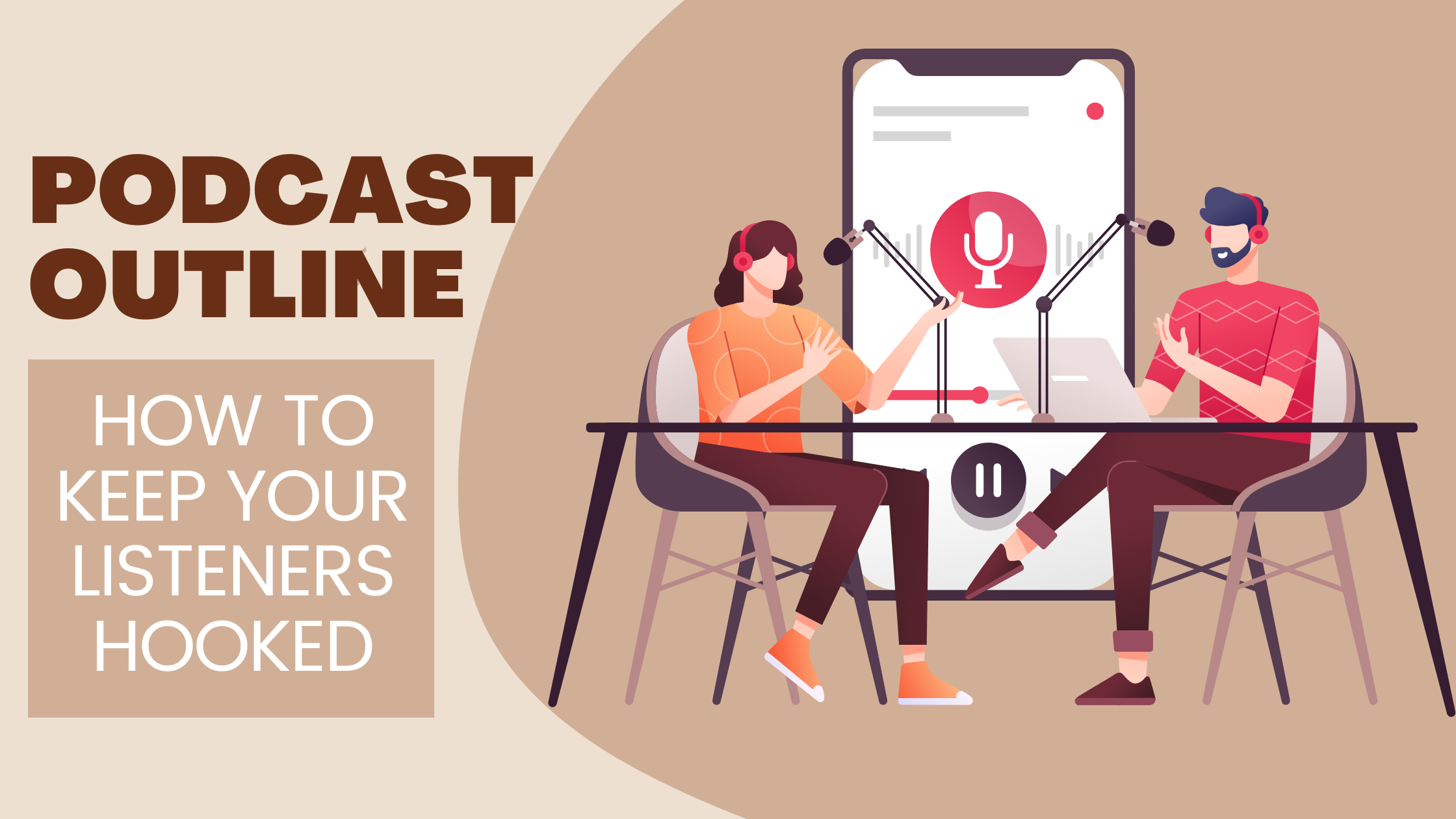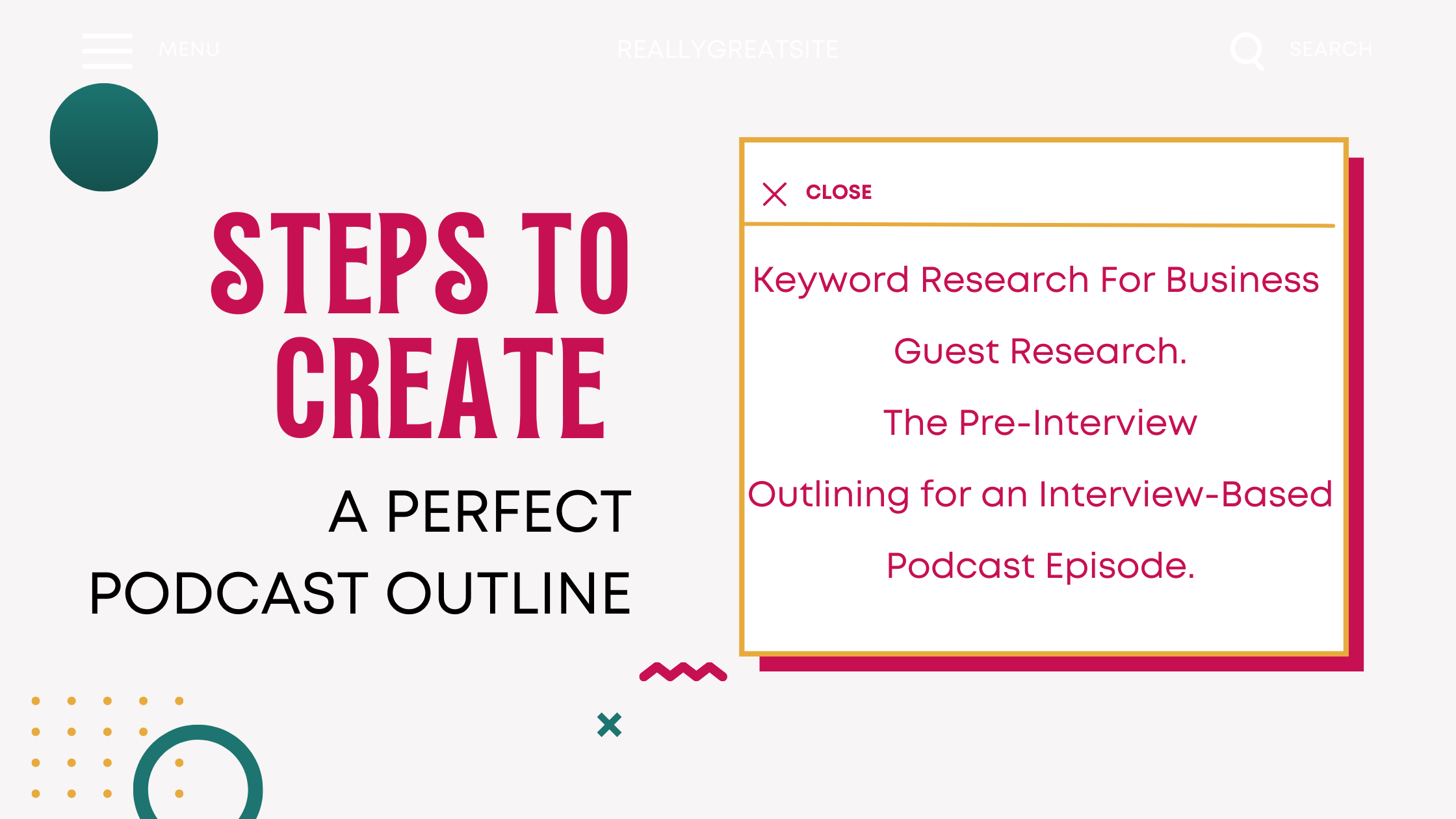
Podcasting combines radio, journalism, and audio production elements, and creating them can be an arduous process. But, all the elements will fall into place if one follows a set approach. As we all know, every podcast is different, and so are the planning processes. But is reading the script more beneficial, or is going outside the outline is important?
Honestly, it is a combination of both, go evolving with your script change and extend beyond your outline whenever you feel the need of it.
So, let’s dive into this podcast world and figure out what fits the best for you.
Importance Of Podcast Outline
The brain is a busy street full of creative ideas walking by each other. Every time you decide to make a podcast or come up with an idea to create a podcast, many ideas and alternatives rush down to be the ones to opt for. With all these amazing ideas, noise pops into the picture. Noise can be a major drawback in podcast creation as it blocks your way to effective communication. At this point, when you get many hurdles standing in your way, you should start generating an outline for the podcast. The use of a podcast outline gives the podcast a form, and so it helps to eradicate all the unnecessary noise and ideas. When you give your podcast the form and shape, it also helps you get feedback from others as a second opinion, and this is how a podcast outline helps to overcome the problems of communication.
Steps To Create A Perfect Podcast Outline .

Recording a podcast without an outline is more like trying to drink a soup with a fork. You might start the process of creating a podcast without an outline but never properly finish it. Without wasting any of your precious time, let me tell you the steps to create the outline for your podcast.
Step 01:
Keyword research for Business Podcasting.
To make meaningful content for your ideal audience, keyword research needs to occur. Keyword research assists you with getting into the brain of your optimal clients and helps you boost your SEO. It makes it tough to achieve an outcome till you don’t know what your target audience wants.
One of the most recommended methods to use for keyword research is GOOGLE ALPHABET SOUP. Google Alphabet Soup is a method in which you type your topic in the google search bar, and google shows you an automated suggestion of the topic you might be interested in searching. It also shows a “people also might search for” bar, which gives you more insights on your topics. Combining all these suggested elements, one can find a good set of useful keywords.
Another way or method to brainstorm for podcast topics is to use questions raised by your customers. If you use this method, your whole show should be centered around your ideal customer and their expertise. This is how you persuade them to be consulted. Nonetheless, it could seem fine to use a client FAQ for an independent episode could seem fine.
Step 02:
Guest Research.
It is crucial to know the guest’s background that you are inviting for the podcast. You can go through their Linkedin and social media accounts, watch their previous interview, read news and blogs related to their profession or related to them. With this, you understand which type of questions the guest is comfortable with and which topics of an interview are not yet asked the guests. This saves lots of time for the interviewer and the guest.
Just knowing about the guest isn’t all the hustle you have to do. Before you reach the research part, you need to find the perfect guest that fits the podcast. There are three types of guests in a business podcast. They are as follows:
(1) External Guests: The guests don’t belong to your organization. They are invited as they match your ICP.
(2) Internal Team Member: These guests are the members of your organization or the members you work with. They can be anyone, from the CEO to the VP of audience growth.
(3) Current Customer: Calling out to your customer base to be the guest for the show and talk about your company and the product is always a great idea. But in this situation, the anchor has to make sure that the conversation is on track and doesn’t become an infomercial.
Step 03:
The Pre-Interview
The pre-interviews are generally held to build a rapport with the guests. It gives the guest a brief idea about all the points to be covered in the interview. The cherry on the cake is that it gives you the guests’ perspective over certain important topics. You can ask the guest to share the what, how, and why of their point of view. With all the information you receive in the pre-interview, you can make changes in the keywords and modulate the questions in the interview.
Step 04:
Outlining for an Interview-Based Podcast Episode.
After the pre-interview, a few things might see the need for a few changes, but there is still necessary to stick to plan 01 and create an outline before the podcast begins recording.
Let’s dive into the specification of the outline for the podcast.
Introduction:
The introduction should obviously and necessarily tell everyone about the guests and the podcast’s topic.
To be specific, the guest introduction should be ideally 30 seconds long, and if any more information about the guest is to be given to the audience, it should be added at the end of the podcast.
The introduction about the topic should cover all the points discussed with the guest in the interview. The introduction helps the listeners to decide whether they want to continue hearing the podcast.
After the introduction, the transition to the interview is a crucial part to be taken care of. The transition should feel natural. Below are mentioned some ideas to make the transition look natural:
Try asking…
In detail about the book written by them over the key topic.
How they generally define the key topic.
What’s special about the key topic.
About the current landscape of the key topic.
About their company’s approach to the key topic.
They just wrote about the article/LinkedIn status on the key topic.
Regarding the press release, their company wrote concerning the key topic.
Interview:
The interview can sound like the hardest part, but to be true, it is the easiest part of the whole podcast as you are just having a conversation with the guest. Although the pre-interview has covered most of the interview part, it is always a smart move to keep follow-up questions handy. Here are some follow-up questions that work in most of the scenarios:
What do you mean by ______?
Why do you trust that?
Why do you think others will not agree?
How could anyone listening this take action ? What is step #1?
How could anyone following your advice potentially get it wrong?
Apart from all these questions and conversation happening simultaneously, it becomes extremely important to keep the conversation on track.
It just some much to remember in the interview part, though it is the easiest part. Here are some points to remember on your fingertips to have an effective interview:
Don’t get caught up in the trappings of the moment, but focus on what your customer is saying — not what you arere going to speak next.
Take notes while the guest is speaking. Ask a lot of open-ended questions to stimulate them to give more detail on the subject they’re discussing, and take down their answers in full sentences. When you want to come back to something they said earlier, say so, then repeat it using your own words.
It’s okay to interrupt if you feel your guest is rambling on about something that does not concern the specific show. It’s your job as a host to keep the conversation on topic for that particular episode.
Your audience doesn’t want to listen to a sales pitch. Rather, they want to listen to tips and tricks on how they can improve their business, their service offerings, etc.
It is fine to disagree with your guest respectfully. It can make for a dynamic episode.
Focus on your actions. Often, you can get caught up in the theory of your processes. But what matters most is what you do in the moment with those ideas.
Don’t drag out conversations that clearly have no relevance or value. You do not need to make further comments on the guest’s cat’s multi-colored whiskers (you asked about them thirty seconds ago).
You represent your audience, so don’t try to sound smarter than everybody. For anyone who isn’t as familiar, what do you mean by _____?
It’s completely normal to be nervous. Interviewing will become more like second nature as you get more episodes under your belt.
Conclusion:
The conclusion summarizes all the major points that were addressed in the interview. You can take this chance and let the guest give their final notes to the beloved audience that heard the guest throughout the interview. It is also important to thank the guest for giving their time and effort to create the podcast. If the guest is comfortable sharing their point of contact, you can also let your audience know ways to contact them through a suitable medium.
AND that marks the end of the interview.
As of now, you are familiar with creating an outline for your podcast; here is an example to add up to your knowledge.
B2B Growth, Ep. 3 Outline
Guests: James Carbary, CEO at Sweet Fish Media (podcast production company)
Main topic: How to utilize a podcast for your ABM campaign.
INTRO
Hello and welcome back to B2B Growth! I’m your host Emily Kingsland, the lead content writer at Sweet Fish Media. Today I am joining with the CEO of Sweet Fish Media, James Carbary (car/berry).
Today we want to talk about how you can use a podcast to supercharge your Absorptive Branding marketing campaign, as well as the steps for launching a business podcast.
Before we speak to James, let’s take a moment to get acquainted. You already know that he runs Sweet Fish Media, but did you know that he created the company during Startup Weekend in 2013? Sweet Fish Media is a podcast production agency which creates marketing podcasts for small and medium sized businesses throughout the UK and Europe.James is not only the founder of Sweet Fish Media is also the author of Content-Based Networking: How to Connect w/ Anyone You Want to Know Instantly. He hails from the Orlando area, and leads a team located around the world.
Quick Tip: Have your guests review the information you’re using to introduce them so they can make any changes they deem necessary (and so they don’t feel embarrassed by a mistake or two).
Thanks for connecting with on this day, James!
TRANSITION
Why don’t you provide us a quick run-down of the concepts people will learn from your book, Content-Based Networking?
INTERVIEW
How do you explain content-based networking?
Can you give me an instance of content-based networking?
What does it feel like to start a podcast to support your ABM campaign?
If I understand correctly, starting a podcast is something important to your listeners during the content-based networking that you do to attract advertising on your show. Am I correct in saying that?
Why hasn’t everyone commenced a podcast to meet anybody they want?
What outcomes have you seen from starting a professional business podcast?
Can listeners expect the same kinds of outcomes?
What’s the initial step someone should take if they want to kick-off a podcast for their ABM campaign? The second and the third step?
What are the basic pitfalls beginner should look out for?
If you could just go back in the past and give yourself one piece of advice about professional business podcasting, what advice would have you given?
CONCLUSION
In summary, listeners who want to start a podcast to help their own ABM campaign should…
Create a list of target accounts and ask them if they would like to be on your podcast stream.
Utilize a pre-interview to build rapport with the absolute buyer and set up their own unique POV.
Inform the guest when the episode is about to go live.
Utilize the important points from the interview to activate your relation with the podcast guest.
Keep the track of the number of conversions your podcast sessions drives.
That’s some solid guidance, James! Anything else you’d like to share?
James, if listeners wants connect with you or find your book, what are the easiest ways?
Thanks again for being on the show! Again, James Carbary, Sweet Fish Media-CEO and a podcasting master guru.
Thank you very much for listening to B2B Growth. Never miss an episode by hitting the subscribe button on Apple Podcasts, Spotify, or wherever you listen to podcasts.
Steps To Be Followed By A Solo Podcaster To Create A Podcast Outline.

The process of creating a solo podcast is less hectic than that of an interview-based podcast. As the podcast just has one speaker, a little less struggle happens on keeping the podcast on track, maintaining the keywords, and having total control over the words flowing in the podcast. Let’s breakdown the solo podcast and focus on every element singularly.
Introduction:
The introduction here includes information about you and the gist of the topic. The introduction should act as the index, in other words, table of contents for the forthcoming podcast.
The Meat:
The need for transition can be canceled off the list for solo podcasts. You can directly skip to the main part and start putting forward all your podcast-related knowledge and POVs. In this segment, you can load people with all your perspective and keywords.
The Conclusion:
As simple as it is, you just have to summarize the central matters. Offer whatever other resources where audience members can fetch more information. Let them know where to associate with you.
Mentioned below is an example of a solo podcast.
Your solo episode outline also doesn’t have to be anywhere near perfect, because you’re the only one looking at it. Just make sure that you go through the motions of writing it out and including everything you want to discuss in the podcast with yourself.
B2B Growth, Ep. 3 Outline (Solo)
Host: Emily Kingsland
Topic: How to utilize a podcast for your ABM campaign
INTRO
Hello and welcome back to B2B Growth, a podcast brought to you by Sweet Fish Media. I’m your host Emily Kingsland, a content writer at Sweet Fish Media. Today, I’m going to discuss with you about five ways in which companies can use podcasting as an effective tool of ABM campaign.
Those steps include…
Create a list of target accounts.
Build their unique POV.
Inform the guest when the episode goes live.
Activate your relationship with the guest.
Measure the effectiveness of your podcast.
Let’s take a look at step #1.
MEAT
Create a list of your target accounts and ask them if they would like to be on your podcast show.
Utilize a pre-interview to create rapport with the potiental buyer and build their unique POV.
Inform the guest when the episode is about to go live.
Use the important points from the interview to activate your relation with the podcast guest.
Keep the track of the number of conversions your podcast sessions drives.
Quick Tip: If you are an expert on the topic, you shouldn’t have to note down everything you want to say over the show. Riffing off bullet points sounds more legitimate, anyways.
CONCLUSION
To support your own ABM campaign with a podcast session, follow the steps we just covered for you.
Create a list of your target accounts.
Hold a pre-interview w/ POV questions.
Reach out when the episode is about to go live.
Use talking points to activate the potential customer.
Measure the effectiveness of your podcast session.
If you wish to learn more about ABM, you can check out Sangram Vajre’s book “B2B Growth,” available on Audible. Or, listen to episode number 2 of B2B Growth here.
To connect with me, you can find me on LinkedIn.
Thanks for listening to B2B Growth, the podcast on business growth. Don’t miss every episode and article we share by subscribing wherever you listen to podcasts like Apple Podcasts, Spotify, or even in your favorite podcast app!
Lastly, here are a few points that you CANNOT MISS ON to make a perfect podcast
Music, sound effects, and other sound assume a significant part in many podcasts. Indeed, even fundamental sound effects can maneuver a podcast into another domain of impressive skill, so consider blending audio and sound effects all through regardless of whether it isn’t focal in your account; consider blending audio and sound effects all through.
Some ways music and sound effects may fit into your podcast:
Intros and outros: theme music or jingle
To reinforce dramatic or comedic moments
To help establish a sense of place in a story
To segue between segments or introduce a guest
As a key talking point in your show
As background filler
You will find tons of resources on the internet to use for different purposes throughout your podcast.
Conclusion:

So as we know, what all are the necessity for creating a podcast outline. Let me give you a perfect conclusion by summarizing the whole in a few words. So here we go:
Do keyword research to discover topics your ideal customers care about.
Research your guest before you start asking dumb questions.
Schedule a pre-interview to uncover your guest’s unique POV.
Use your notes from the pre-interview to create a well-informed episode outline.

